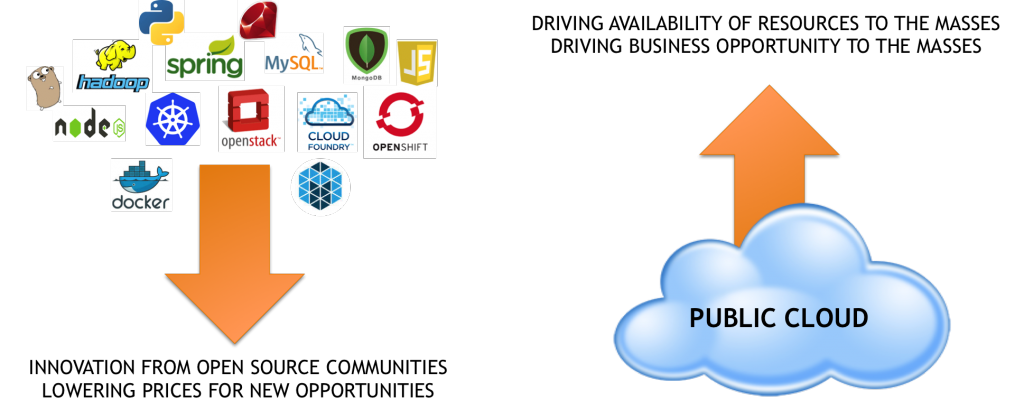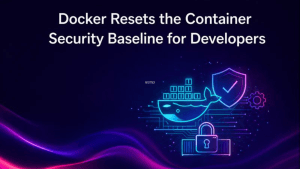[NOTE: This research is the first of a two-part series of research looking at how open source software is having an impact on both end-user companies and vendors. Part I is Open Source Software: Enabling Enterprise IT Innovation.]
Premise: In the domain of cloud computing, there are two forces that are having a significant impact on the vendor landscape – public cloud computing and open source software. Wikibon has forecasted the public cloud vs. private cloud markets out through 2026, with roughly 33% of all IT spending moving to the public cloud. But what role will open source software play in shaping how IT vendors (hardware and software) bring technology to market and capture revenues from customers?
More and more enterprise IT organizations are making open source software a priority in their decision-making criteria for new infrastructure and application usage. This trend will have an impact on venture capital, startups, established IT vendors and cloud providers as they evolve their portfolio of offerings.
- Venture Capital: Outside of Red Hat, most companies have struggled to profitably monetize a business that has open source software at the core. Recently, venture capitalists A16Z, Accel Partners, and Battery Ventures all either held events or have been openly speaking about the struggles of startup companies to monetize their open source software and communities. This challenge has been well defined in the book The Software Paradox, which is leading many startups to begin looking at adjacent SaaS offerings that can augment their core open source offering (e.g. Docker Cloud, Pivotal Web Services, Weave Scope).
- Startups: Over the past 2-3 years, several billion dollars of venture capital funding has been invested in open source centric companies (e.g. Apprenda ($20M), Chef ($40M), Cloudera ($900M), ClusterHQ ($12M), CoreOS ($28M), Docker ($113), Mesosphere ($74M), Pivotal ($253), Puppet Labs ($40M) , Rancher Labs ($20M), Sysdig ($15M), Weave ($16M)). As these types of companies move towards later rounds of funding, they must each determine a monetization model that is acceptable to customers, satisfies their investors, and will help them continue to attract engineering talent that is already in high demand.
- Established IT Vendors: Many established IT vendors have been heavily involved with open source software for many years (e.g. Cisco, HPE, IBM, Intel, Red Hat, etc.) through direct contribution to projects such as Linux, Hadoop, and OpenStack. But their involvement was often not directly aligned to their business model, where proprietary hardware and software were the primary market offerings. These vendors are now facing pricing pressures as free open source software is the basis for increasing portions of the workloads running on or over their hardware, as well as new customer demand that software be made freely available to evaluate prior to any selection process.
- Cloud Providers: The current cloud providers have all used open source software to scale out their global infrastructure footprint. Now they are offering a variety of services (e.g. DBaaS, Containers-as-a-Service, BigData-as-a-Service, etc.) that simplify how end-customers are able to consume these powerful, yet complex services for their business needs. In addition, many of the cloud providers are beginning to bring open source projects into the public domain (e.g. AWS DSSTNE, Google Tensorflow) and into open source foundations (e.g. Google Kubernetes).

Rethinking Open Source Centric Business Models
For many years, IT vendors attempted to become “the Red Hat of <insert new technology>” by using a technique called “open core”, where they would offer a free version of a popular open source project, but then charge customers for proprietary add-ons. This is a model that has been widely used in the big data (e.g. Hadoop) market. The drawback of this model is that it creates a level of uncertainty between the vendor and the project’s open source community, as it’s not always clear what functionality will eventually be free vs. for-fee.
The recent shift in thinking around business models is that monetization is moving to the public cloud, either for the entire project or adjacent aspects of the project. Many companies are beginning to deploy SaaS or SaaS-like applications to augment the core open source project in a way that could be customized and monetized. This is an interesting strategy for several reasons:
- By offering open source software packages as an on-demand service (e.g. OPEX pricing) instead of as a perpetual license (e.g. CAPEX pricing), many vendors will now have to manage multiple sales compensation models for their sales force. The on-demand model may be highly desired by customers, but it might be discouraged by vendor sales teams that do not get compensated at a similar level as on-premises offerings. [NOTE: Several software vendors with existing installed base (e.g. Microsoft, Oracle) are compensating their sales teams at 5-7x for public cloud deals to encourage a behavior that moves purchases to a cloud-based model. These purchases are not always based on open source software, but they do highlight how the vendor market is adjusting to new customer demands to leverage new consumption models.]
- If the software is open source, then cloud providers can also offer the technology as-a-Service directly to customers (e.g. AWS DBaaS for MySQL, Azure Container Service (Docker Swarm or Mesosphere DCOS), Google Cloud Kubernetes-as-a-Service for Orchestrating Containers, IBM BlueMix (Cloud Foundry), Rackspace (OpenStack Private Cloud). Depending on which layer in the stack the open source software resides (e.g. above the virtualization layer), there are also opportunities for vendors to offer their software package on top of public cloud services (e.g. Docker Cloud, Red Hat OpenShift Online, Pivotal Web Services, etc.).
- Delivering on-demand cloud services that augment open source software comes at a different operational cost than just delivering packaged software. The on-demand services must be built, operated and maintained regardless of customer usage levels, which adds on-going costs for the business. The on-demand offerings typically offer a “free tier” or “free trial” which becomes a part of the acquisition cost for a new customer. Business that offer these services must have programs in place to track online usage and be able to quickly integrate them with their programs to contact sales leads and drive follow-up business.
Augmenting Proprietary Hardware and Software with Open Source
Many established vendors are beginning to augment their traditional go-to-market programs with new programs that highlight their involvement with open source software communities. Some examples include:
- Cisco – The DevNet program is designed to enable developers to become more proficient at a wide range of Cisco and non-Cisco technologies, including sample code, workshop trainings and sandbox environments to develop code.
- EMC – The EMCcode program is designed to create and contribute to open source projects with a focus on DevOps, Infrastructure-as-a-Code and Storage.
- Intel – 01.org highlights the breadth of projects that Intel sponsors in order to accelerate the availability of computing resources for a wide range of use cases.
- Hewlett Packard Enterprise (HPE) – HPE’s open source participation expands from Linux to infrastructure to high performance computing programs.
- VMware – The VMware open source program is focused on projects to augment and enhance virtualization and container-centric infrastructure.
As these programs evolve, they will most likely evolve from just being a set of open source tools to the vendors taking a more strategic role within various open source projects. This may include the vendor open sourcing technology that had previously been close sourced, in order to adapt to compete market demands.
Action Item: While the pace of open source technology is rapidly increasing, with new (and overlapping) projects coming out each year, it is important for end-user customers to understand both the open source project and the leading companies driving the project. It will be important to ask vendors how they plan to monetize their offerings, or if they plan to offer extended support contracts (if needed). For many end-user customers, the need to look at both on-premises and public cloud versions of open source may be necessarily to hedge the risk for any given project, as well as to augment the existing technical skills of an IT organization.


